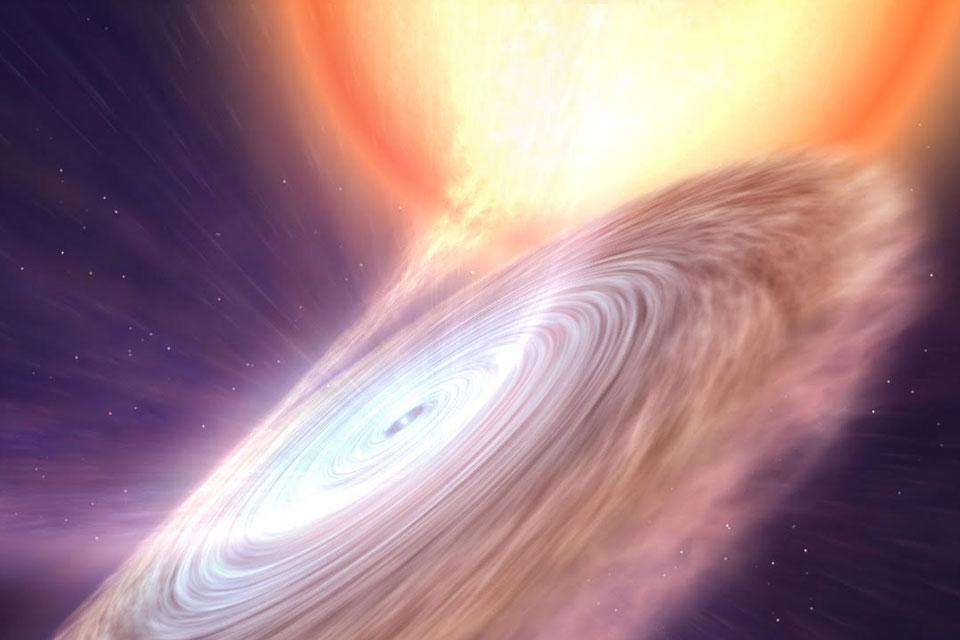Using the most powerful telescopes on Earth and in space, a team of astronomers has found for the first time, blasts of hot, warm and cold winds from a neutron star while it consumes matter from a nearby star. The discovery provides new insight into the behaviours of some of the most extreme objects in the universe.
Low-mass X-ray binaries (LMXBs) are systems containing a neutron star or black hole. They are fuelled by material ripped from a companion star, a process known as accretion. Most accretion occurs during violent eruptions where the systems brighten dramatically. At the same time, some of the material that spirals in is propelled back into space in the form of disc winds and jets.
International collaboration
The most common signatures of outflowing material from astronomical objects are associated with ‘warm’ gas. Despite this, only winds of ‘hot’ or ‘cold’ gas have been observed in transient X-ray binaries, until now. In this new study, a team of researchers from eleven countries, led by the University of Southampton, studied the recent eruption of the X-ray binary known as Swift J1858. They used a combination of telescopes, including NASA’s Hubble Space Telescope (HST), the European Space Agency’s XMM-Newton satellite, the European Southern Observatory Organisation’s Very Large Telescope (VLT) and the Spanish Gran Telescopio Canarias (GTC).
The results, published in the journal Nature, showed persistent signatures of a warm wind at ultraviolet wavelengths occurring at the same time as signatures of a cold wind at optical wavelengths. This is the first time that winds from such a system have been seen across different bands of the electromagnetic spectrum.
Swift J1858: special
Lead author Dr Noel Castro Segura, of the University of Southampton said: ‘Eruptions like this are rare, and each of them is unique. Normally they are heavily obscured by interstellar dust, which makes observing them really difficult. Swift J1858 was special, because even though it is located on the other side of our galaxy, the obscuration was small enough to allow for a full multiwavelength study.’
‘Only one other system — the black hole X-ray binary, V404 Cyg — has shown similar properties. However, our attempt to perform the same experiment on that system was unsuccessful, because the eruption ended before we could get the ground-based and space-based telescopes to observe it simultaneously,’ co-author Dr Hernández Santisteban from University of St Andrews said.
Swift J1858 is a newly discovered X-ray transient event that displays extreme variability across the electromagnetic spectrum, which presented a rare opportunity.
Exciting observing campaign
‘It has been exciting to be part of such a large, multi-wavelength, international observing campaign for this source,’ adds Lauren Rhodes, DPhil student at Oxford and co-author. ‘Projects like this demonstrate the importance of collaborative science in transient astrophysics.’
As well as discovering the different types of winds, the team were able to study the temporal evolution of the outflowing gas. They found that the warm wind was not affected by the strong variations in the brightness of the system. The absence of such a response had previously been an unconfirmed theoretical prediction based on sophisticated simulations.
‘The new insights provided by our results are key to understanding how these accreting objects interact with their environment. This is important, because by shedding energy and matter into the galaxy, they contribute to the formation of new generations of stars, and to the evolution of the galaxy itself,’ Dr Castro Segura concluded. The study was funded by grants from agencies including the Science and Technologies Facilities Council (STFC) and NASA among others.
A persistent ultraviolet outflow from an accreting neutron star transient, N Castro Segura et al, Nature, 2 March 2022

